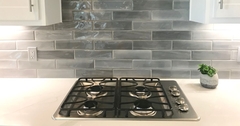
The kitchen is undeniably the heart of the home, and its design plays a pivotal role in creating a space that is not only functional but also aesthetically pleasing. When it comes to kitchen aesthetics, the combination of stone countertops and backsplashes is a timeless and sophisticated choice. The art of mixing and matching different stones in these two crucial areas can elevate the overall look of your kitchen. In this blog post, we'll explore the nuances of combining stone countertops with backsplashes, offering insights into the design possibilities, considerations, and tips for creating a harmonious and visually stunning kitchen space.
Understanding the Power of Stone
Stone has been a staple in kitchen design for centuries, and for good reason. It not only exudes a sense of luxury and durability but also brings a natural element that enhances the overall ambiance of the space. Granite, marble, quartz, and other natural stones are popular choices for countertops, each offering unique patterns, textures, and colors. When paired with stone backsplashes, these materials create a cohesive and sophisticated look that can stand the test of time.
Harmonizing Colors and Tones
Consideration: The key to a successful mix-and-match strategy is achieving harmony in colors and tones between the countertop and backsplash. While it's not necessary to match the exact color, finding complementary hues or shades creates a cohesive and visually appealing look.
Tips
Neutral Elegance: Opt for neutral tones like white, gray, or beige for both the countertop and backsplash. This timeless combination provides a versatile canvas for other design elements in the kitchen.
Contrast for Impact: If you prefer a bolder aesthetic, consider contrasting colors. Dark countertops with a lighter backsplash or vice versa can create a striking and dynamic visual impact.
Sample Swatches: Before making a final decision, obtain sample swatches of both the countertop and backsplash materials to assess how they look together in different lighting conditions.
Playing with Patterns
Consideration: The pattern of the stone can significantly influence the overall aesthetics of your kitchen. Balancing patterns between the countertop and backsplash is crucial to avoid overwhelming the space.
Tips
Mixing Patterns: If your countertop has a bold and intricate pattern, consider a more subdued or solid color for the backsplash. Conversely, a simple and understated countertop can be complemented with a more elaborate backsplash design.
Consistent Veining: Choosing stones with consistent veining patterns, such as marble or quartz, can create a seamless flow between the countertop and backsplash.
Pattern Scale: Pay attention to the scale of patterns. Large-scale patterns on the countertop can be balanced with smaller-scale patterns on the backsplash and vice versa.
Embracing Texture
Consideration: Texture adds depth and visual interest to your kitchen design. Combining different textures in stone countertops and backsplashes can enhance the tactile and visual experience of the space.
Tips
Polished and Honed Finishes: Pairing a polished countertop with a honed or matte backsplash, or vice versa, creates a beautiful contrast in texture.
Natural Stone Variations: Natural stones like granite and slate offer unique textures. Embrace these variations by using the same stone for both the countertop and backsplash for a cohesive, textured look.
Subtle Textural Elements: If you prefer a more subtle approach, consider introducing texture through smaller elements, such as tiles with a raised pattern or a textured backsplash against a smooth countertop.
Creating Visual Flow
Consideration: Achieving a seamless and harmonious flow between the countertop and backsplash contributes to a well-designed kitchen. The goal is to create a visual connection that ties the two elements together.
Tips
Continuous Material: Using the same material for both the countertop and backsplash creates a seamless and cohesive look. This approach works particularly well with materials like quartz or marble.
Color Gradation: Gradating colors from the countertop to the backsplash or vice versa can create a sense of continuity while introducing subtle variations.
Open Shelving: If you have open shelving in your kitchen, consider extending the stone from the countertop onto the backsplash and even the shelves. This creates a unified look that visually connects different elements in the kitchen.
Balancing Boldness
Consideration: While a bold design statement can be captivating, it's essential to strike a balance to avoid overwhelming the space. Combining bold elements in both the countertop and backsplash requires careful consideration of scale and visual weight.
Tips
Focal Point: Designate one area, either the countertop or the backsplash, as the focal point with a bold pattern or color. Keep the other elements more subdued to maintain balance.
Contrasting Elements: If you opt for a bold countertop, consider a more neutral or complementary backsplash. Conversely, a vibrant backsplash can be balanced with a more understated countertop.
Test with Temporary Elements: Experiment with bold design elements using removable or temporary solutions, such as peel-and-stick tiles, before committing to permanent installations.
Considering Practicality
Consideration: While aesthetics are crucial, practicality and functionality should not be overlooked. Stone countertops and backsplashes are functional elements in the kitchen, and their durability and maintenance requirements should align with your lifestyle.
Tips
Ease of Cleaning: Choose materials that are easy to clean and maintain, especially for areas prone to spills and splashes. Granite, quartz, and porcelain tiles are excellent choices in this regard.
Sealing Natural Stones: If you opt for natural stones like marble or granite, be aware of their sealing requirements. Regular sealing helps protect the stone from stains and ensures longevity.
Heat Resistance: Consider the heat resistance of the chosen materials, especially for the countertop near cooking areas. Quartz and granite are known for their heat-resistant properties.
Conclusion: Crafting Your Culinary Oasis
The art of mixing and matching stone countertops with backsplashes is a creative endeavor that allows you to express your personal style while enhancing the functionality of your kitchen. By carefully considering color harmony, pattern balance, texture variations, and overall visual flow, you can create a culinary oasis that seamlessly combines aesthetics and practicality. Whether you opt for a classic and timeless look or a bold and contemporary design, the key is to strike a balance that transforms your kitchen into a space that is both visually stunning and highly functional. Embrace the art of mixing and matching, and watch as your kitchen becomes a true reflection of your taste and personality.

